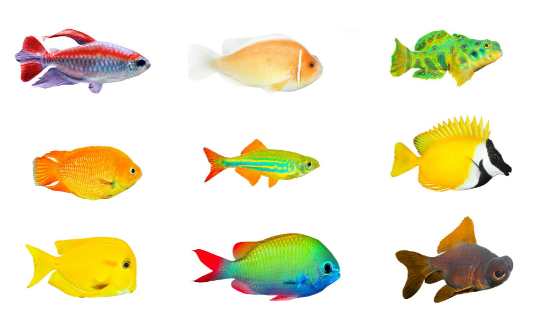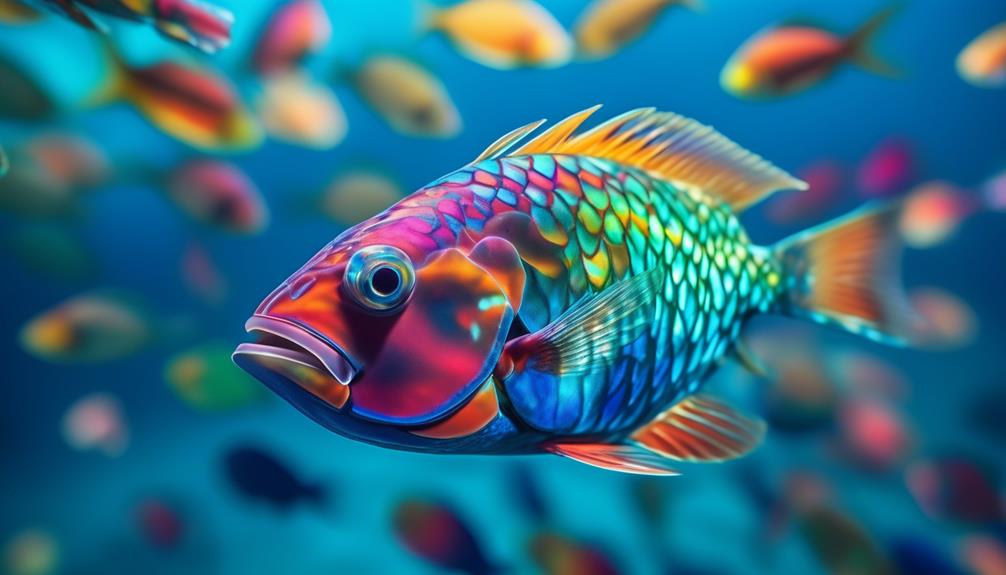
Have you ever wondered what lies beneath the surface of the ocean, hiding away in its colorful depths? Well, prepare to be amazed by the vibrant beauties known as parrotfish. These remarkable creatures boast a dazzling array of hues, from vivid reds and blues to striking greens and yellows. But their stunning appearance is just the beginning of their allure.
These fish also play a crucial role in maintaining the delicate balance of the ocean ecosystem. Intrigued? Stay with us as we unravel the mysteries of these captivating creatures, exploring their unique characteristics, feeding habits, and the challenges of caring for them.
Get ready to be immersed in the enchanting world of colorful parrotfish.
Key Takeaways
- Parrotfish are large, non-aggressive saltwater fish found in tropical and sub-tropical oceans.
- They have vibrant colors and patterns, ranging from shades of red, blue, green, yellow, orange, grey, and black.
- Parrotfish have parrot-like beaks made of compressed teeth and feed primarily on algae, contributing to bioerosion.
- They require a very large aquarium (200 gal) and are not suitable for beginner aquarists.
Overview of Parrotfish Species
When it comes to the diverse world of parrotfish species, you’ll be amazed by their vibrant colors, unique beaks, and their important role in maintaining the health of coral reefs.
With over 90 distinct species, these saltwater fish are known for their striking shades of red, blue, green, yellow, orange, grey, and black, adorned with various patterns.
Their parrot-like beaks, made of compressed teeth, allow them to feed on algae, which not only sustains their own diet but also contributes to the bioerosion of coral reefs.
As non-aggressive and peaceful creatures, they can be kept in very large aquariums. However, their large size and specific feeding habits make them unsuitable for beginner aquarists.
Habitat and Distribution of Parrotfish
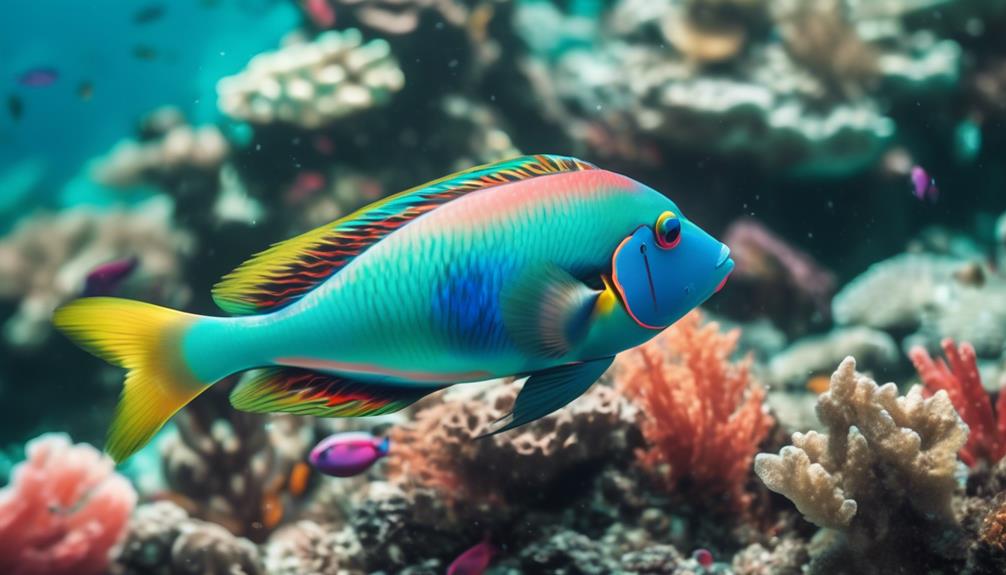
Parrotfish inhabit tropical and sub-tropical oceans, contributing to the vibrant colors and biodiversity of these underwater ecosystems. They can be found in various regions, including the Caribbean Sea, the Indo-Pacific Ocean, and the Red Sea. These colorful fish are known to inhabit coral reefs, seagrass beds, and rocky areas within these habitats.
They play a crucial role in maintaining the health of these ecosystems by feeding on algae and contributing to bioerosion. Parrotfish are well-adapted to their surroundings, with their parrot-like beaks made of compressed teeth allowing them to scrape algae off coral and rocks.
Their vibrant colors, including shades of red, blue, green, yellow, orange, grey, and black, not only make them visually stunning but also help with camouflage and communication within their social groups.
Unique Characteristics of Parrotfish

With their vibrant colors and distinctive beaks, parrotfish possess unique characteristics that set them apart in the underwater world. These fascinating creatures have a number of interesting traits that make them stand out:
- Parrot-like beaks made of compressed teeth: Parrotfish have specialized beaks that resemble those of parrots. These beaks are actually made up of compressed teeth, which they use to scrape algae off rocks and coral.
- Vibrantly colored with various patterns: Parrotfish come in a wide array of eye-catching colors, including shades of red, blue, green, yellow, orange, grey, and black. Their vivid hues and intricate patterns make them a truly spectacular sight.
- Feed primarily on algae: Parrotfish play a crucial role in maintaining the health of coral reefs by feeding on algae. They help prevent the overgrowth of algae, which can smother and kill coral.
- Large size requires a spacious aquarium: Due to their size, parrotfish require a very large aquarium, typically around 200 gallons, to thrive in captivity.
- Peaceful and beautiful species: Despite their size, parrotfish are generally non-aggressive and peaceful. They make stunning additions to aquariums and bring a sense of tranquility to any underwater environment.
Feeding Habits and Diet of Parrotfish
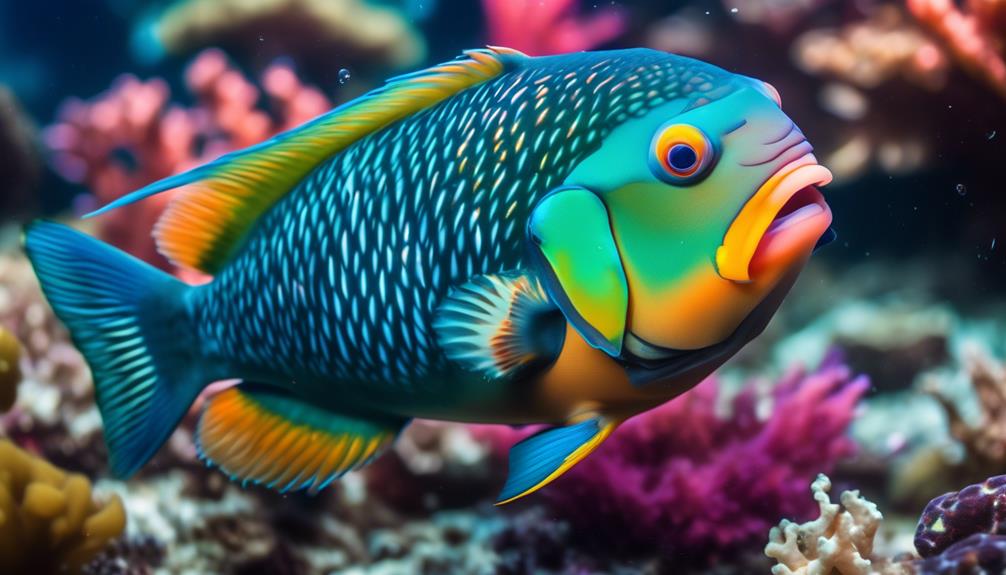
To ensure the health and well-being of your parrotfish, it is important to understand their feeding habits and diet. Parrotfish primarily feed on algae, which makes up the majority of their diet. They use their parrot-like beaks, made of compressed teeth, to scrape algae off rocks and coral. However, they can also be trained to accept shrimp and seaweed sheets as part of their diet. Due to their large size, parrotfish require a spacious aquarium with plenty of algae for them to graze on. Breeding parrotfish can be difficult due to their size, so it is recommended to have them in a species-only tank. By providing a suitable diet and environment, you can ensure that your parrotfish thrive and display their vibrant colors.
| Feeding Habits | Diet |
|---|---|
| Feed primarily on algae | Algae |
| Can be trained to accept shrimp and seaweed sheets | Shrimp and seaweed sheets |
| Large size requires a spacious aquarium | – |
| Breeding difficult due to large size | – |
| Lifespan of up to 13 years in captivity | – |
Care and Maintenance of Parrotfish in Aquariums
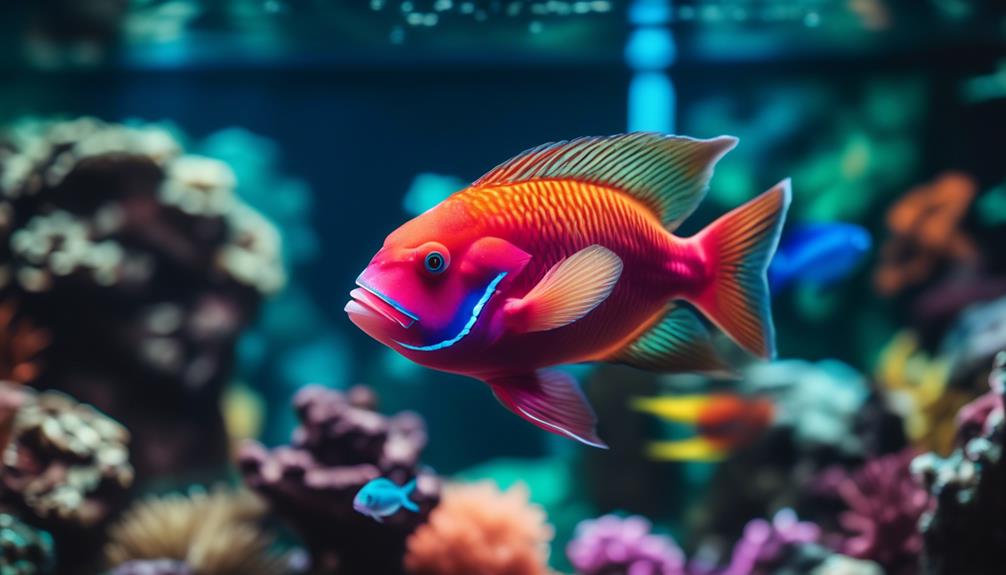
Understanding the care and maintenance required for parrotfish in aquariums is essential to ensure their vibrant colors continue to thrive. To properly care for parrotfish in your aquarium, consider the following:
- Provide a very large aquarium, preferably 200 gallons or more, to accommodate their size.
- Maintain a peaceful environment as parrotfish are non-aggressive and prefer compatible tank mates.
- Create a suitable swimming region in the middle of the tank, ensuring ample space for their natural behavior.
- Offer a diet primarily consisting of algae, but also consider training them to accept shrimp and seaweed sheets.
- Regularly monitor water quality, temperature, and salinity to provide a healthy and stable environment for the parrotfish.
Suitable Tank Mates for Parrotfish
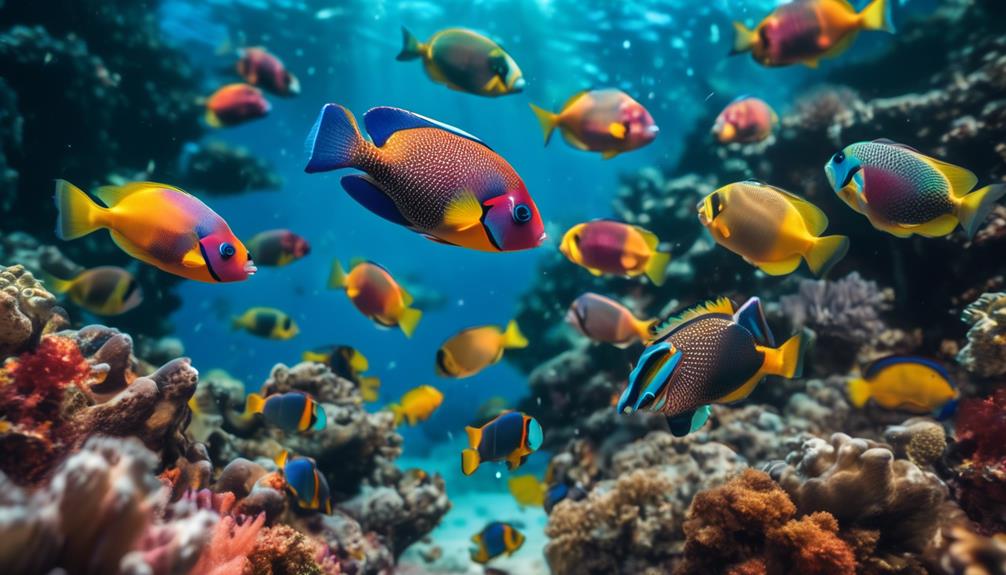
Parrotfish can peacefully coexist with a variety of tank mates in your aquarium. Their non-aggressive temperament makes them compatible with other peaceful species.
Some suitable tank mates for parrotfish include angelfish, anthias, batfish, boxfish, butterflies, clownfish, and hogfish. These species can share the same swimming region in the middle of the aquarium, creating a visually appealing and diverse environment.
It’s important to ensure that the tank mates are of similar size to avoid any potential conflicts. Additionally, providing ample hiding places and territories will help establish a harmonious community.
With the right tank mates, your parrotfish can thrive and create a stunning display of color and beauty in your aquarium.
Breeding Challenges and Considerations for Parrotfish
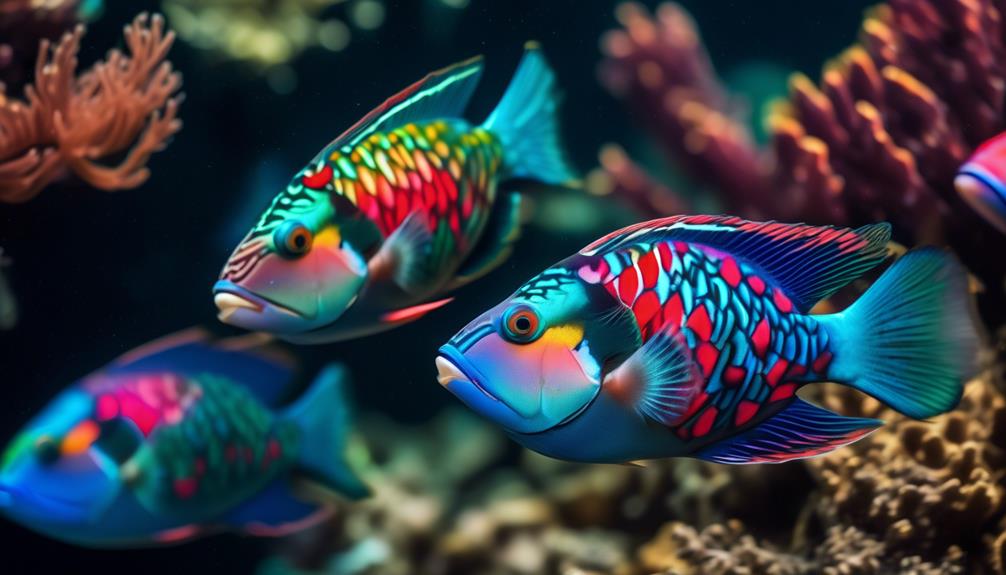
When considering breeding challenges and considerations for parrotfish, it’s important to understand the unique aspects of their reproductive process. Here are some key points to keep in mind:
- Complex mating behavior: Parrotfish engage in a variety of mating behaviors, including territorial displays and color changes to attract mates.
- Sex-changing ability: Many species of parrotfish are sequential hermaphrodites, meaning they can change sex throughout their lifespan. This can make it challenging to pair individuals for breeding.
- Spawning behavior: Parrotfish typically release their eggs and sperm into the water column during spawning events, which can make it difficult to control and monitor breeding in a captive setting.
- Large size: Parrotfish can grow quite large, which means they require spacious aquariums for breeding, as well as specialized care and feeding.
- Limited knowledge: Despite their popularity in the aquarium trade, there’s still much to learn about the reproductive biology of parrotfish, making successful breeding a challenge.
Understanding these challenges and considerations can help aquarists make informed decisions when it comes to breeding parrotfish.
Lifespan and Longevity of Parrotfish in Captivity
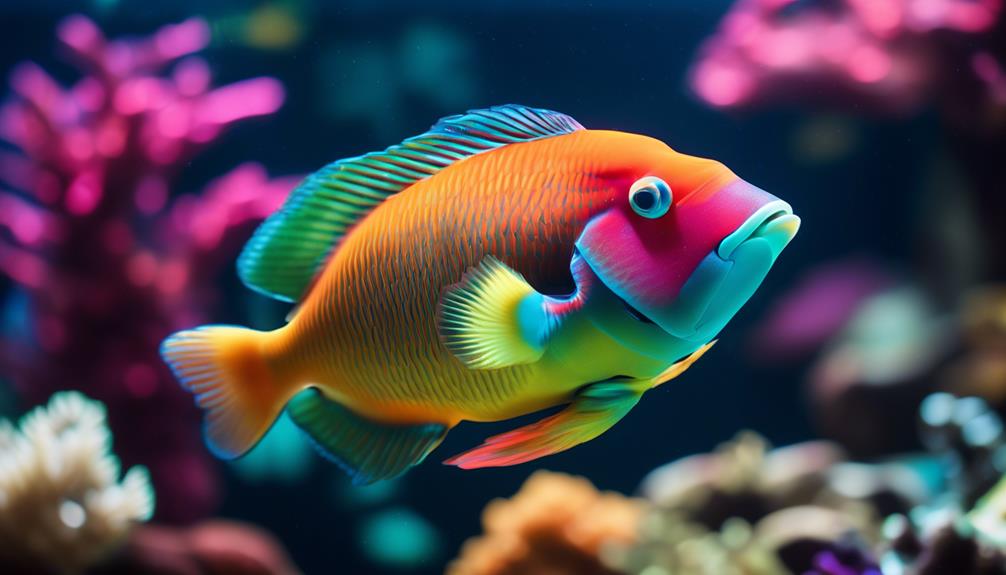
The average lifespan of Parrotfish in captivity can reach up to 13 years. When properly cared for, these colorful beauties can bring joy to your aquarium for over a decade. Providing them with a spacious tank, suitable tank mates, and a balanced diet is essential for their longevity.
Parrotfish primarily feed on algae, but they can also be trained to accept shrimp and seaweed sheets. However, breeding Parrotfish in captivity can be challenging due to their large size.
It’s important to note that their lifespan can vary depending on various factors such as water quality, diet, and overall care. By creating a suitable environment and meeting their specific needs, you can ensure that your Parrotfish live a long and vibrant life in captivity.
Conservation and Importance of Parrotfish in Ecosystems
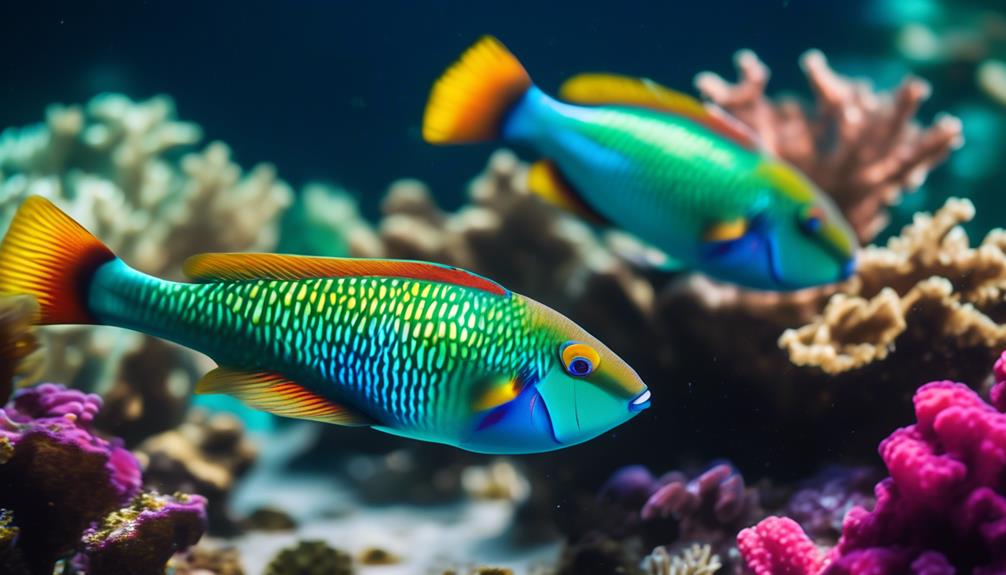
Playing a crucial role in maintaining the health and balance of marine ecosystems, the conservation and preservation of Parrotfish is of utmost importance. These vibrant creatures aren’t just beautiful to look at, but they also have a significant impact on the ecosystem they inhabit.
Here are five reasons why Parrotfish are essential for the environment:
- Algae control: Parrotfish feed on algae, preventing it from overgrowing and smothering coral reefs.
- Coral reef maintenance: Parrotfish play a key role in bioerosion, breaking down dead coral and allowing new coral to grow.
- Sand production: Their constant grazing on coral reefs results in the production of fine sand, which helps create and maintain beaches.
- Biodiversity support: Parrotfish provide food for other marine species, contributing to the overall diversity of the ecosystem.
- Climate change resilience: Healthy coral reefs, maintained by Parrotfish, act as carbon sinks, helping mitigate the effects of climate change.
Frequently Asked Questions
Can Parrotfish Change Their Colors?
Yes, parrotfish can change their colors. They are known for their vibrant hues, which can range from shades of red, blue, green, yellow, orange, grey, and black. This ability helps them blend in with their surroundings and attract mates.
How Long Does It Take for a Parrotfish to Reach Its Full Size?
It takes a while for a parrotfish to reach its full size, but they grow steadily over time. On average, it can take several years for them to reach their maximum size.
Can Parrotfish Live in Freshwater Aquariums?
No, parrotfish cannot live in freshwater aquariums. They are saltwater species that require the specific conditions of tropical and sub-tropical oceans. Keep them in a large saltwater aquarium for their well-being.
Are Parrotfish Aggressive Towards Other Fish in the Aquarium?
Parrotfish are non-aggressive towards other fish in the aquarium. They are peaceful and beautiful species that can coexist with tank mates like angelfish, anthias, batfish, and more.
Can Parrotfish Be Trained to Perform Tricks or Tasks?
No, parrotfish cannot be trained to perform tricks or tasks. They are peaceful and beautiful species found in tropical and sub-tropical oceans. Their vibrant colors and unique feeding habits make them a fascinating addition to any aquarium.
Are Parrotfish and Molly Fish similar in terms of vibrant colors and beauty?
Yes, parrotfish and molly fish in aquariums are both known for their vibrant colors and beauty. Parrotfish are famous for their stunning hues and unique patterns, while molly fish are cherished for their dazzling array of colors, making both species popular choices for aquarium enthusiasts.
Conclusion
In conclusion, the colorful parrotfish are truly a remarkable species that showcase the beauty and diversity of the ocean. Their vibrant shades and unique patterns make them a sight to behold.
While they may pose challenges in terms of care and breeding, their important role in the ecosystem can’t be overlooked. By understanding and appreciating these magnificent creatures, we can contribute to their conservation and ensure their presence in our oceans for generations to come.




